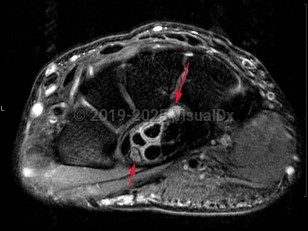Carpal tunnel syndrome
See also in: Nail and Distal DigitAlerts and Notices
Important News & Links
Synopsis
When the bundle of flexor tendons and median nerve in the synovial sheath enter the narrow passageway on the palm side of the wrist and continue between the carpal bones, the nerve (being the softest structure) is most at risk of injury. The median nerve provides sensory innervation to the first three and a half fingers and motor innervation to the lumbricals, opponens, abductor pollicis brevis, and flexor pollicis brevis, the latter 3 muscles making up the bulk of the thenar eminence. When compression occurs within the confined space of the tunnel, the thumb, index, middle, and half the ring fingers develop tingling or numbness. Weakness and atrophy of the thenar eminence can also occur
Symptoms are often noticed at night or on waking; radiating pain or numbness from wrist to elbow may be present. Severe cases may progress to muscle wasting, most notable in thumb abduction, and can lead to permanent disability.
A particular cause may not be determined, but associated risk factors are obesity, trauma, arthritis, diabetes, hypothyroidism, edema, acromegaly, oral contraceptives, gout, rheumatoid arthritis, pregnancy, and wrist sprain or fracture.
The condition is exacerbated by prolonged or repetitive motion of wrist extension or flexion, such as writing, holding a book, typing, and driving. Further difficulty gripping objects, opening jars, and buttoning clothes may occur with weakening of thumb and finger abduction and opposition, and as thenar eminence atrophy progresses. Symptoms usually begin intermittently but become more constant if it progresses without treatment.
Carpal tunnel syndrome is often misdiagnosed in older patients with Parkinson disease due to loss of dexterity and nonspecific sensory symptoms.
Codes
G56.00 – Carpal tunnel syndrome, unspecified upper limb
SNOMEDCT:
57406009 – Carpal tunnel syndrome
Look For
Subscription Required
Diagnostic Pearls
Subscription Required
Differential Diagnosis & Pitfalls

Subscription Required
Best Tests
Subscription Required
Management Pearls
Subscription Required
Therapy
Subscription Required
Drug Reaction Data
Subscription Required
References
Subscription Required
Last Updated:05/10/2020

